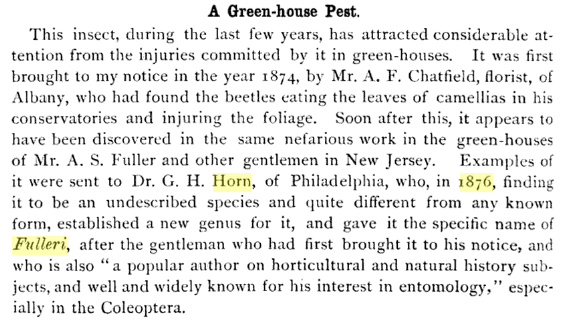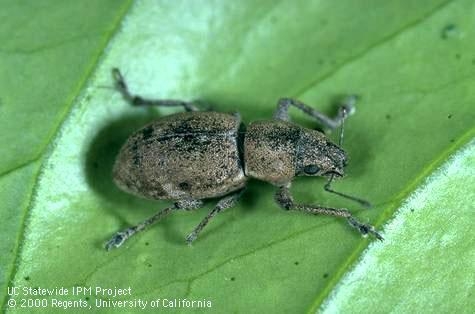https://books.google.com/books?id=-Xy5qw-v_b4C&pg=RA1-PA142&lpg=RA1-PA142&dq=Aramigus+fulleri+Horn+1876&source=bl&ots=0GU5nJKuaZ&sig=lXNWBaMfvRyzgZhBGLmUyuAJFrs&hl=en&sa=X&ved=2ahUKEwi654nhl_jeAhWJjFQKHQMVAcYQ6AEwEHoECAoQAQ#v=onepage&q=Aramigus%20fulleri%20Horn%201876&f=false
https://archive.org/stream/journalof626419541956newy/journalof626419541956newy_djvu.txt
Weiss: Fuller
185
ANDREW S. FULLER, EARLY ECONOMIC ENTOMOLOGIST
OF NEW JERSEY, 1828 - 1896
By Harry B. Weiss
From a biographical viewpoint some of our early writers on insects
have been neglected in our entomological literature in favor of their
more prolific and outstanding contemporaries. Andrew S. Fuller was
one of such persons. Only a brief mention was made of him in
Entomological News (June, 1896, p. 192) shortly after his death. The
only other biographical reference to him in entomological literature
occurs in L. O. Howard's "History of Applied Entomology”, (Wash-
ington, D. C., 1930), in which his portrait is reproduced on plate 5.
Fuller, an editor, horticulturist, amateur entomologist and writer
was born at Utica, New York, on August 3, 1828, and brought up in
a region devoted to fruit growing. His parents moved to a small farm
near Barre, New York, where he attended a country school and helped
around the farm. After his parents had moved to Milwaukee, Wis-
consin, in 1846 he learned carpentering and with his interest in plants
he started to devote his activities to the construction of greenhouses,
becoming in 1855 the manager of the greenhouses belonging to W. R.
Prince of Flushing, Long Island. This position he held for two years.
He then moved to Brooklyn, New York, and began to cultivate small
fruits, paying particular attention to strawberry improvement. Soon
he began to v/rite articles on horticulture for "Life Illustrated,” the
"New York Tribune” and other papers. The "Tribune” at one time
distributed, as circulation premiums, 300,000 of Fuller's strawberry
plants. And in 1862 his first book "The Illustrated Strawberry Cul-
turist” appeared. In 1851 he married Jennie Clippens and in I860
he moved to Ridgewood, New Jersey, and bought a tract of land
which he improved and then used for experimental purposes.
His articles continued to appear in the agricultural and horticul-
tural press. During 1866 and 1867 he edited Woodward's "Record
of Horticulture.” From 1868 until 1894 he was editor of the "Weekly
186
New York Entomological Society [Vol. lxii
Sun” and while connected with this paper he was responsible for
the distribution of seed white potatoes with subscriptions. In 1871
he became the associate editor of "Moore's Rural New Yorker” later
the "Rural New Yorker”, becoming part owner and editor-in-chief
in 1876. However within a year he severed these connections. He
was a member of various organizations and when the New Jersey State
Horticultural Society was organized for the second time in 1875 he
was one of its founders and its vice-president from Bergen County.
At the January, 1876, meeting of this society, in a paper on entomol-
ogy and its relation to horticulture, he stressed the need for knowledge
about injurious insects and said that future progress depended largely
upon success in controlling insects.
His books include "The Grape Culturist”, 1864; "The Forest Tree
Culturist”, 1867, which was translated into the German language;
"Practical Forestry”, 1884; "The Propagation of Plants”, 1887; and
the "Nut Culturist”, 1896.
In addition to the accumulation of a large horticultural library, he
collected insects and minerals. He specialized in the Coleoptera, for
his collection of which he built a special house. His interests also
embraced the study of prehistoric American pottery. At the time
of his death from a heart attack on May 4, 1896 he was a staff writer
for the "Florists' Exchange,” the "American Agriculturist” and the
"American Gardener”.
From 1868 to 1896 he was the author of some 28 papers on a
wide range of economic insects as may be noted by his list of titles
in Henshaw's "Bibliography of American Economic Entomology”
Parts IV and V, 1895 and 1896. He was also the author of a paper
on "Collecting Insects, How to Collect and Transport Them”, 5 pages,
22 V 2 cm., with no place or date of publication.
Fuller frequently sent insect specimens or descriptions of insects to
the editors of the "American Entomologist” for identification. In
the "Answers to Correspondents” in the columns of that magazine
and its successors, Fuller's questions and the editors' answers may be
Sept., 1954]
Weiss: Fuller
187
found in Vol. 1, Nos. 3, 4, 10, 11; Vol. 2, Nos. 4, 8, 10. Similar
references may be found in the "Practical Entomologist”, Vol. 2, No.
9, and in "Insect Life” Vol. 1, page 86. Of Fuller's inquiries nearly
all dealt with species injurious to grapes, strawberries, seeds, black-
berries, etc. On July 16, 1888, he wrote to C. V. Riley about insects
confused with the Hessian fly prior to the Revolution and Riley re-
plied in "Insect Life” that there was no evidence of the existence of
that insect in America at that early period. At times, various writers
have confused the work of the Angoumois grain moth with that of
the Hessian fly. [See Journ. Econ. Ent. Vol. 37, page 838]
When the "American Entomologist” began for a second time in
January 1880, after a lapse of ten years, Andrew S. Fuller was
assistant editor, and C. V. Riley was editor. However the October,
1880, issue contained only Riley's name as editor, with the announce-
ment that Fuller had retired from his editorial duties. During the
summer of 1880, Fuller had been in New Mexico where his interests
were likely to call him at any time.
In 1875 Fuller sent specimens of a beetle that he had collected in
Montana to Dr. George H. Horn who described it as Aramigus fulleri
in 1876. Since then it has been known as Fuller's rose beetle. In
his "History of Entomology” Essig gives an interesting account of
the spread of this beetle over the world. It was originally collected
by Crotch on brambles at Fayal on the island of Horta, Azores, in
1866 and described by him in 1867 in the Proceedings of the Zoo-
logical Society of London. It received little attention until it appeared
in many parts of the United States and was described again by Horn.
Andrew S. Fuller died on May 4, 1896. An obituary presumably
written by Frederick Allen Eddy and published in a Bangor, Maine,
newspaper shortly after his death refers to Fuller's home in Ridge-
wood, New Jersey, having been transformed from a barren waste to
one of the finest places in Bergen County all through the efforts of
Mr. Fuller who was an enthusiast in botany and other natural sci-
ences. Upon his Ridgewood home specimens of nearly every nut
tree in the world were growing, as well as other trees and plants.
188
New York Entomological Society [Vol. lxii
After her husband's death Mrs. Fuller, around December 7, 1897,
sold her husband's collection of Coleoptera to Frederick Allen Eddy
of Bangor, Maine, and it became a part of, or perhaps the basis of
Mr. Eddy's large beetle collection which came to the Museum of
Comparative Zoology at Harvard College, Cambridge, Massachusetts,
after Eddy's death in 1935. Dr. P. J. Darlington, Jr., Curator of In-
sects, Museum of Comparative Zoology, to whom I am indebted for
the above and the following information advised me that according
to a note left by Eddy the Fuller material was in 112 boxes and
included some 4,500 species and 15,000 or 20,000 specimens. Eddy
paid $1,050 for it. The Fuller collection included much rare material
identified by good specialists. Some of it was material from Prof.
Snow of Kansas. Mr. Eddy combined the Fuller collection with his
own and at the Museum of Comparative Zoology the Eddy specimens
are being incorporated in the general collection of North American
beetles. The Fuller specimens were not labelled as such by Eddy
and as he received specimens from many other sources it is difficult
to identify, exactly, the Fuller beetles. However it is assumed that
most of the specimens in the Eddy collection bearing only state ab-
breviations as localities and not labelled by Eddy, are Fuller's. Such
specimens now bearing the label "Frederick Allen Eddy Collection”
in the general collection are probably those of Fuller.
References
Crawford, Nelson Antrim. Andrew S. Fuller. Dictionary of Ameri-
can Biography, New York, 1931.
Hexamer, F. M. Andrew S. Fuller sketch in Bailey's Cyclopedia of
American Horticulture, III, p. 6 16. 1906.
Woodward, Carl R. The Development of Agriculture in New Jersey,
1640-1880. 1926, p. 235.
Obituaries in New York Sun, May 5, 1896; New York Tribune, May
5, 1896; American Agriculturist, May 16, 1896.

